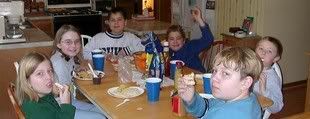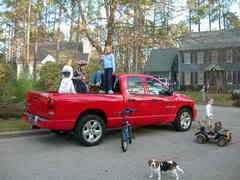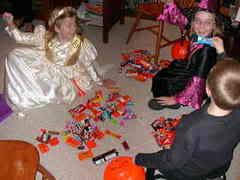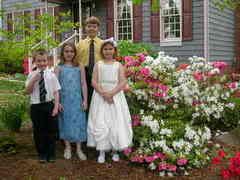This is my friend’s story, but it could so easily have been mine Or yours. One year ago today, she died from melanoma, but there were more culprits than the cancer in her death: an ozone layer that’s being depleted, economic policies that favor profits over medical research, a culture that still worships the sun, and a society that tells women to get gorgeous–no matter the physical harm to our bodies.
She also died, in part, from just being a typical American mom. Because when her husband said, “Honey, I think that mole on your back looks funny,” did she call the doctors? Nope. She had kids to get to soccer practice and dance recitals. There were bike tires to pump, laundry to be folded, an elderly father who needed care. She put it off, and it killed her. By the time those few months went by between her first noticing the changing mole and her getting to the doctors, the lymph nodes were involved, and her fate was sealed.
But although this is a sad story, there is much of light and hope to take away. Sp please allow me to introduce you to my friend:
The Good Neighbor
A Tribute to Beth Shafer
Nov 22, 1965 – June 27, 2004
To have a good neighbor is to find something precious. –Chinese proverb
Most of us grew up with images of good neighbors taken straight from those 1950’s TV shows–you know, the smiling ladies who show up with fresh-baked pies when you first move in, the friendly backyard barbeques, the shared gardening equipment, those kinds of icons of American life.
My experiences with neighbors living in New York and Boston were always pleasant, but rather distant. Let’s face it–“good” neighbors meant people who kept away—those whose lives, guests, and tastes in music did not intersect your own life. Oh, people waved, kept their lawns mowed, sometimes chatted at the mailboxes, and always had Halloween treats for the kids, but mostly, “good” neighbors meant people who were quiet, kept to themselves and let you enjoy your own privacy.
All that changed when we moved to North Carolina.
It started with invitations to pop in for coffee before the house contract was even signed. It continued with offers to help paint, suggestions on finding new pediatricians, and a warm “friendship cake” delivered to our door the first week we moved in.
All of my new neighbors were friendly, caring, involved, but cul de sac life seemed especially energized by one neighbor–our “Miss Beth,” as the kids all called her. My first impression of Beth Shafer was the day we came with the realtor to see the house. Beth was in her yard, pushing one child on a swing while balancing another baby on her hip. About four or five other children seemed to be swirling around her–ranging from toddlers to ten year olds. All were giggling, running, laughing, and all were very much under Beth’s watchful eye. She was grinning, too, and loving every minute of the noise and play. She came over to introduce herself, and took time, while the whole group of adults and kids gathered in close, to show off the tiny new bluebird eggs in the nest of the bird house on her front tree. I wondered, how does she manage all those kids? Later of course, I learned only two were Shafer kids–the rest were children of other neighbors, all drawn to Beth`s backyard. In my mind, the value of our new house increased when I leaned my future new neighbor was a former 1st grade teacher, with such a warm place in her heart for children–and baby bluebirds! What a great person to have for a neighbor, I thought then.
Soon my own two kids were in the throng, and our favorite time of day became “driveway time,” watching the kids play and bike around the cul-de-sac while the grownups shared stories of their day. We cheered on each other’s kids as they went without training wheels, and we cheered on each other as we faced new babies, family illnesses, school problems, job loss.
There were special days, too–those kinds of unofficial holidays, like the first day there were enough leaves on the ground to rake into a big pile. Beth might have spent half the afternoon raking her front and back yard, but gladly did it all again without a complaint because the kids just had so much fun jumping in the leaves. Or the first day the neighborhood pool opened for the season, when we’d all gather up our pool toys and listen to the girls share stories about choosing colors for their new bathing suits. Beth would be the first mom outside with the camera when the kids took up homemade instruments to march in an impromptu parade, the one to catch the season’s first firefly, or the first to take the lead of a game of “Ghost in the Graveyard.”
Snow days were my special favorites. Our neighbors two doors down have a long sloped driveway, and are so generous that when it snows, not only do they park their car out in the street, but they leave their driveway surface packed with snow so all the kids can enjoy a small sledding run. The children would play until they were wet and cold, and the moms would take turns bringing out styrofoam cups of hot chocolate and popcorn to eat on Miss Beth’s back porch
We became friends. Like women everywhere, kids and daily trials brought us together–as well as an uncanny “small world” syndrome as we kept discovering things we had in common–we had attended the same upstate NY college, had been married in the same year weekend, and other “believe-it-or-not” overlaps. I’m sure the proximity and day to day contact helped, but I like to think we would have become friends even if we hadn’t ended up as next door neighbors.
And yes, our entire cul-de-sac lived out all the “neighbors” clichés. We shared lawn equipment–my hedge trimmer, her spreader, another neighbor’s rototiller. We borrowed cups of sugar, cake decorating equipment, traded hand-me-down clothes. One pair of snowpants, I think, has now been on every child on the block. We were forming strong bonds, and the kids knew they could trust any of the adults to look out for them. We may not have realized it as much, but we were taking care of each other, too.
Then one day Beth had her own news to share. Devastating news. The melanoma she hoped she’d beaten was back. The doctors talked in terms of months when they described how long she’d have left. They used words like “metastasis” and “stage four.” We didn’t believe it. We were horrified. We prayed. We hoped. We cried.
But we also rallied `round. Because that’s what good neighbors do for each other–from rides and childcare to meals and lawn care, and oh so many prayers, what Beth had always given came back to her now, tenfold. Finally, though, Beth had to lay down the burdens of this world and give her life back to God. She died in the home she loved, surrounded by family and friends who loved her.
The Hospice people who attended her— and Hospice workers are truly angels here on earth— talked about dying being not so much a matter of physical factors but of finishing your “soul’s work.” Some people hang on longer because of the “work” of dying that they still need to finish. Beth must have done her homework well. She went quickly, peacefully, surrendering gracefully with barely 24 hours between “We’ve called in Hospice” and “Beth died tonight.”
How do you measure the impact of a life?
Almost everyone I know in our area I first met through her introductions. As news of her cancer spread, I was in awe of how many people knew Beth–at how many families she had touched. There’s a hole now in our lives. I step out of my door, and I just can’t believe she’s not going to be in her small garden, trying to find some gentle way to keep the rabbits from eating her peas. I see her children riding their bikes, and I can’t believe she’s not right there behind them, heading off to the greenway. I keep looking for her at the mailbox, expecting her to be waving from the back porch, and it keeps hurting when I realize she’s not there.
But then I see flowers she planted, and next to those, the flowers planted by loving friends when the cancer kept her inside more often than not, and I think, it’s a cliché, but it does ring true in my heart–what Beth planted here on earth still grows. There are so many things that stand in tribute to what a wonderful woman she was.
Beth was a teacher until the end; she talked with school groups, Scout troops, and swim teams about her illness and about wearing sunscreen. She agreed to participate in experimental drug trials, even though she knew a cure wasn’t for her, just so the drugs’ impact could be measured for some unknown future patient.
She was deeply spiritual in a non preachy way, with a faith that made her think the best of everyone and work for programs like Meals on Wheels, Crop Walks, and many, many smaller volunteer programs. She was an unforgettable first grade teacher, who saw the best possibilities in each of her students. And she was a strong Democrat, believing in the “love they neighbor” parts of the Bible and feeling that a progressive agenda was the best way to help the most people.
Mostly, what I take away from my good neighbor is her attitude–in the kind of mindset that when I casually asked, one ordinary day years before her illness was known, “How are you?” she could say, “You know, it’s such a glorious day, and I just feel so full of God’s love here in this sunshine, how could I feel anything but wonderful?!”
So those of you who knew never knew her can still honor her memory. Introduce yourself to a newcomer. Trade names at the local store with people you don’t know. Practice a random act of kindness for your own neighbors. Bake extra cookies and send them around to the folks down the street. Try to buy something–any little thing–from that kid who knocks on the door for a school fundraiser. Fly your flags; help each other. Be that good neighbor. Wear sunscreen. And each time you do, Beth will be smiling, I know.
A gaggle of the kids gather inside on a snow day for snacks:

A neighbor’s new truck is christened by all the cul de sac kids climbing in:

After trick-or-treating each year, the gang gathers for a trading session that rivals Wall Street:

The Brown and Shafer kidlets pose in their Sunday best:





